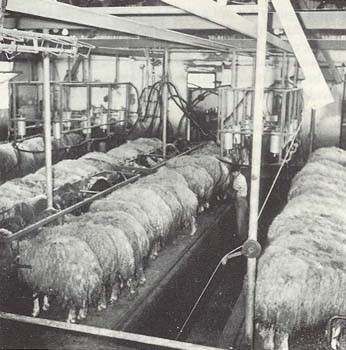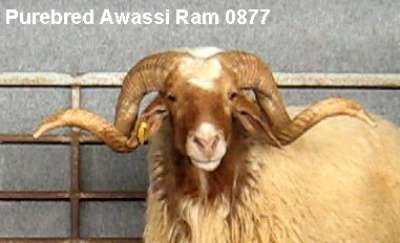<!--<!--<!--<!--
AWASSI SHEEP BREED

The Awassi is the most common sheep breed in the Arab countries and would seem to be close to the prototype from which the fat-tailed breeds of sheep derive. It is also the highest milk producing breed in the Middle East. Because of its ability to thrive under the local conditions, the Awassi is a natural choice for any genetic improvement. The name allegedly comes from the El Awas tribe which roamed between the Tigris and Euphrates rivers.
<!--<!--<!--[if gte mso 10]> <mce:style><! /* Style Definitions */ table.MsoNormalTable {mso-style-name:"جدول عادي"; mso-tstyle-rowband-size:0; mso-tstyle-colband-size:0; mso-style-noshow:yes; mso-style-priority:99; mso-style-qformat:yes; mso-style-parent:""; mso-padding-alt:0in 5.4pt 0in 5.4pt; mso-para-margin-top:0in; mso-para-margin-right:0in; mso-para-margin-bottom:10.0pt; mso-para-margin-left:0in; line-height:115%; mso-pagination:widow-orphan; font-size:11.0pt; font-family:"Calibri","sans-serif"; mso-ascii-font-family:Calibri; mso-ascii-theme-font:minor-latin; mso-hansi-font-family:Calibri; mso-hansi-theme-font:minor-latin;} -->
The Awassi evolved as a nomadic sheep breed through centuries of natural and selective breeding to become the highest milk producing breed in the Middle East. The breed is of the Near Eastern fat-tailed type. The average Awassi ewe has single lactations over 300 liters (650 pounds) per 210-day lactation, and it is not uncommon for outstanding females to have 210 day lactations above 750 liters (1,625 lbs).
As a comparison, the lactation of the average U.S. sheep breed is about 100 to 200 pounds per lactation. The breed also has the advantage of natural hardiness and grazing ability. The males are horned and the females are usually polled. The fleece is mostly carpet type with a varying degree of hair.

The Awassi has been 'improved' for milk production and this type is larger and more refined than the unimproved Awassi which is a medium size, robust sheep. The fat tail gives an appearance of imbalance between the fore and hind quarters while the large udder adds to the impression. Height at the withers ranges from 68 to 80 cm in mature rams and 65 to 70 for ewes. Weight ranges from 30 to 90 kg depending on sex and condition with dairy animals at the top end of the range. Some rams may exceed 100 kg.

Why Choose Awassi?
- Introduce hardiness and ability to walk long distances into existing flocks
- Awassi sheep browse as well as graze - very versatile in low rainfall areas
- Awassi is the preferred breed for the Middle Eastern live sheep market as well as offering huge potential for carcase export
- Strong Australian demand from people of Middle Eastern origin, with the tail fat highly prized.
- Awassi store most of their fat in their tail, not on the carcase
- Awassi fat has a lower melting temperature (like beef) - doesn’t congeal in your mouth like most sheep breeds
- Increase milk production - better lamb growth
- High milk yields - ideal for sheep dairies
- Very long lactations
- Ease of lambing
- Very easy on fences

The head is long and narrow. A noticeable characteristic of the Awassi are the ears which are quite pendulous. The nose is convex with most rams carrying horns of 40 to 60 cm length which curve back and down with the tips directed outwards. Awassi rams in Bedouin flocks occasionally have up to six horns. The ewes are usually polled (hornless). The neck is reasonably long and tassels are often present. The chest is of moderate width and depth with a small, thin dewlap and prominent brisket. Narrow chests are common in unimproved herds.

The back is long and straight with the rump sloped to the fat tail. The barrel is deep and wide. The tail is broad and relatively short, ending above the level of the hocks. Tails of much greater length make milking difficult. The tail hangs in two lobes and is bare of wool on the lower side. The average length is 18cm and the width 15-16 cm. In rams, the tail may weigh up to 12 kg. Six kilos is the average for ewes.

In the improved dairy type of Awassi, the udder is well attached and extends well to the rear, is of moderate depth and globular in shape. The teats hang down and are of reasonable length.

Short, stiff hair covers the head and ears. The rest of the body is covered with wool. The fleece consists of an outer coat, undercoat and kemp. It has the coarseness and resilience needed for carpet wool. The wool is open and has a moderate lustre with distinct, wide crimps.
Generally the wool will disappear from the neck area at twelve to fifteen months of age, leaving the throat and neck short-haired
with a ridge on the top surface. Rams have a fringe of longer, coarser wool extending along the dewlap to the lower part of the brisket. Quite long, coarse hair replaces wool on the belly as the animal ages. The legs are usually covered with short hair rather than wool, and end with dark brown, sturdy hooves. Fleeces are generally light due to the low density of wool follicles and the fact that much of the sheep does not bear wool. Annual fleece weight varies enormously with unimproved rams producing 2 to 2.5kg annually and ewes around 1.75kg. These weights improved with improved Awassis and in flocks selected for heavier fleeces. More wool is obtained from dry ewes and by shearing twice a year. A typical fleece is white with a yellowish tinge. The head, ears and back of the neck are brown. Occasionally, animals with black, white, grey or spotted faces are found. The whole or parts of the leg are brown. There may be a white blaze.

awassi(75%) x suffolk(25%) ewes
The Awassi is fully adapted to the sub tropical, semi arid or arid regions of southwest Asia. Depending on the area, they may live entirely outdoors feeding on the natural grasslands. In other areas, they may be given some poor quality hay during particularly cold weather.

awassi flock
During the hot months they protect their heads from solar radiation by keeping their heads below the bellies of their flock mates. The pigmentation of the head decreases the risk of sunburn and skin cancers of the area. However tough the Awassi may be in hot climates, it may succumb to ill-health if a succession of rainy or cold days, plus a lack of feed, leads to the depletion of the fat reserves in the tail leaving the animal susceptible to death from exposure and starvation.
They are able to regulate the heat balance of their bodies in varying ways. The fleece traps a layer of still air between the skin and the atmosphere. Epstein and Herz (1964) reports that the average body temperature of Awassi sheep in Israel was 0.9oC lower than that of imported meat sheep kept under the same conditions. Pulse rate of the Awassi lowers in summer, another useful adaptation to the local climate. The flocks of the Bedouins are able to cover hundreds of kilometres in their migrations. After years of domestication and close herding practices, including regular hand-milking, the temperament of the Awassi is very quiet. It is an easy breed to work with.
In Israel, the Awassi has been selected for milk production over a number years and the average yield may now exceed 400kg with an average 7.5% fat. Milking by machine takes 4-6 minutes.
The Awassi breed is found worldwide from Canada to New Zealand.



ساحة النقاش